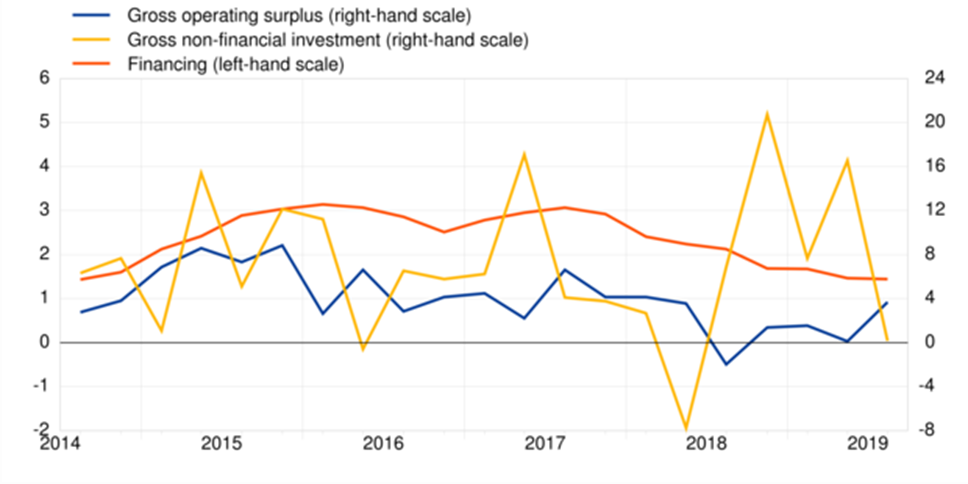- PRESS RELEASE
- 14 January 2020
Households and non-financial corporations in the euro area: third quarter of 2019
- The annual growth rate of loans to households stood at 3.5% in the third quarter of 2019, after 3.4% in the previous quarter. The financial investment of households increased at a broadly unchanged rate of 2.4% and their gross non-financial investment increased at a higher rate of 4.9% (after 4.4%), while their net worth increased at a higher rate of 5.3% (after 4.3%).
- The annual growth rate of the gross operating surplus of non-financial corporations (NFCs) was 3.7% in the third quarter of 2019, higher than in the previous quarter (0.1%). Gross entrepreneurial income increased at a higher rate of 2.5% (after 1.6%). The annual growth rate of NFCs' gross non-financial investment decreased to 0.1% (from 16.6%, which mainly reflected the import of intellectual property products), while their financing increased at a broadly unchanged rate of 1.4%.
Chart 1. Household financing and financial and non-financial investment
(annual growth rates)
Chart 2. NFC gross-operating surplus, non-financial investment and financing
(annual growth rates)
Households
The annual growth rate of household gross disposable income increased in the third quarter of 2019 at an unchanged rate of 3.5% as compared with the previous quarter. Similarly, gross operating surplus and mixed income of the self-employed increased at an unchanged rate of 3.1%, while compensation of employees grew at a lower rate of 3.5% (after 3.7%). Household consumption expenditure increased at an unchanged rate of 2.5%.
The household gross saving rate in the third quarter of 2019 was 13.0%, compared with 12.8% in the previous quarter.
The annual growth rate of household gross non-financial investment (which refers mainly to housing) increased to 4.9% in the third quarter of 2019, from 4.4% in the previous quarter. The annual growth rate of loans to households, the main component of household financing, stood at 3.5% (after 3.4%).
The annual growth rate of household financial investment stood at a broadly unchanged rate of 2.4% in the third quarter of 2019. Among its components, currency and deposits grew at a higher rate of 5.3% (after 4.9%), and investment in life insurance and pension schemes grew also at a higher rate of 2.8% (after 2.3%). Conversely, investment in shares and other equity decreased at a slightly higher rate of -0.4% (after -0.1%), and investment in debt securities further declined at a higher rate of -8.0% (after -3.4%).
The annual growth rate of household net worth increased to 5.3% in the third quarter of 2019, from 4.3% in the previous quarter, mainly driven by higher valuation gains in financial assets. The household debt-to-income ratio stayed broadly unchanged at 93.6% in the third quarter of 2019 as compared with the third quarter of 2018, as disposable income grew at broadly the same pace as loans to households.
Non-financial corporations
Net value added by NFCs increased at a higher rate of 3.9% (after 3.0%) in the third quarter of 2019. Gross operating surplus increased to 3.7% year-on-year, from 0.1% in the previous quarter, and net property income (defined in this context as property income receivable minus interest and rent payable) decreased. As a result gross entrepreneurial income (broadly equivalent to cash flow) increased at a higher rate of 2.5% (after 1.6%).[1]
The annual growth rate of NFC gross non-financial investment decreased to 0.1% (from 16.6%, which mainly reflected the import of intellectual property products).[2] Financing of NFCs increased at a broadly unchanged rate of 1.4%, as the increase in the annual growth rate of issuance of debt securities and equity by NFCs as compared with the previous quarter was compensated by a decrease in the growth rate of loan financing.
NFCs' debt-to-GDP ratio (new consolidated measure) increased to 78.1% in the third quarter of 2019, from 77.6% in the third quarter of 2018; the non-consolidated, wider debt measure decreased to 140.0%, from 140.4%.
NFC financial investment grew at a broadly unchanged annual rate of 1.8%. Among its components, increases in the growth rate of currency and deposits, and of shares and other equity, as well as a lower disinvestment on debt securities were compensated by a reduction in the growth rate of loans granted.
Annexes
For media queries, please contact Andrea Zizola, tel.: +49 69 1344 6551.
Notes
- The annual growth rate of non-financial transactions and of outstanding assets and liabilities (stocks) is calculated as the percentage change between the value for a given quarter and that value recorded four quarters earlier. The annual growth rates used for financial transactions refer to the total value of transactions during the year in relation to the outstanding stock a year before.
- Hyperlinks in the main body of the press release are dynamic. The data they lead to may therefore change with subsequent data releases as a result of revisions. Figures shown in annex tables are a snapshot of the data as at the time of the current release.
- [1]Gross entrepreneurial income is the sum of gross operating surplus and property income receivable minus interest and rent payable.
- [2]Gross non-financial investment is the sum of gross fixed capital formation, changes of inventories, and the net acquisition of valuables and non-produced assets (e.g. licences).
Europos Centrinis Bankas
Komunikacijos generalinis direktoratas
- Sonnemannstrasse 20
- 60314 Frankfurtas prie Maino, Vokietija
- +49 69 1344 7455
- media@ecb.europa.eu
Leidžiama perspausdinti, jei nurodomas šaltinis.
Kontaktai žiniasklaidai

